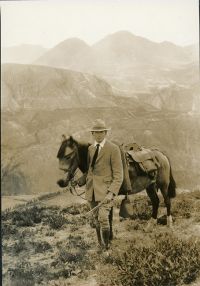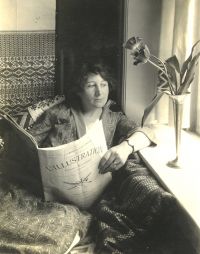Frederick Wilson and Dorothy Popenoe
British-born Dorothy K. Hughes was an African grass specialist and scientific illustrator hired at the Washington office of the United States Department of Agriculture in July 1923. While there, she met and married F. Wilson Popenoe, an agricultural explorer specializing in South American crops. "Pop" was largely responsible for popularizing the use of avocadoes in American kitchens in the nineteenteens.
In January 1925 the Universidad Mayor de San Marcos in Lima, Peru, conferred an honorary doctorate of sciences on Wilson Popenoe. During his trip from Washington to receive his only college degree, Pop took the Ecuador photographs reproduced here. He observed and photographed plant usages with an eye toward potential economic crops for the United States. Following plants from field to market, he also captured South American labor practices. The problems and politics of such encounters appear in the archived correspondence that accompanies this collection of hundreds of photographs. For example, Dorothy Popenoe wrote to Wilson in 1924 from Panama: "Down by the stream [a] young woman with her baby was doing the inevitable washing, beating it against the stones. The shadow of a tree fell across her and we asked her to move into the sunlight that we might take her photograph. But nothing would induce her to do it as she didn't like Americans. I was reminded of your tale of the Guatemalan Indian who wanted nothing but to be left alone."
Wilson Popenoe amassed a collection of intimate documentary photos, which were both ethnographic and botanical, of seldom-recorded lifestyles from Central and South America in the first half of the twentieth century. He had a stark documentary style reminiscent of Lewis W. Hine's 1908–1921 work for the National Child Labor Committee. The reproductions here have not been cropped or cleaned, showing both the photographic aging process and Popenoe's sharp eye for composition and light.
Late in 1925 Dorothy and Wilson moved to Tela, Honduras, where he started the United Fruit Company's Lancetilla Agricultural Experiment Station. As the station land was cleared, Dorothy was drawn to the Mayan artifacts unearthed there. Happiest when intellectually challenged, she easily turned her talents to archeology and described her grueling archaeological digs in several scholarly journals. Dorothy's artworks were a more traditional form of scientific illustration than Wilson's. While they reflect her changing intellectual focus, her finely executed pen-and-ink stipple drawings focused on one object or set of objects and used traditional methods of shading and arrangement. Together, the Popenoes' works exemplified the broad range of artistic practices attached to the sciences.

Frederick Wilson Popenoe (1892–1975), Ecuador, 1921, photograph by an unknown photographer, HI Archives portrait no. 5.

Dorothy Popenoe (1899–1932), unknown location, unknown date, photograph by an unknown photographer, HI Archives portrait no. 3.